The 10 Kitchen Trends for 2026 That Will Make Your Remodel Project Feel Like It's Ahead of the Design Curve
The styles, materials, colors, and layouts for forward-looking kitchen designs that still have timeless appeal


Kitchen trends tend to be in a slower cycle than in other rooms of the house, and it's probably for the best. These spaces are expensive and disruptive to change, so longevity, whether that's down to durable choices or styles that'll endure the fickle nature of design, is often top of a renovation wishlist.
The good news for 2026 is that the kitchen trends really breaking through have proven staying power — in fact, they're often drawn from the more distant past. This isn't the traditional meets modern that we're used to, which subtly sits on the fence between two styles. Rather, it's a style of kitchen design that pits opposing styles against each other, creating a new interior design trend that's more than the sum of its parts.
The colors we're choosing for kitchens are rich and storied, yet still feel fresh in their unexpectedness, while the materials we feel drawn to all belie that desire for the human touch in interiors still, even in the age of hyper-digitization.
Most of all, the dream kitchen of 2026 speaks directly to the person cooking in it. Its personality is not only formed by that unique mix of materials, colors, and styles that define a person's 'taste', but also the opportunities to customize it, very specifically.
1. The Mood: Heritage Modern
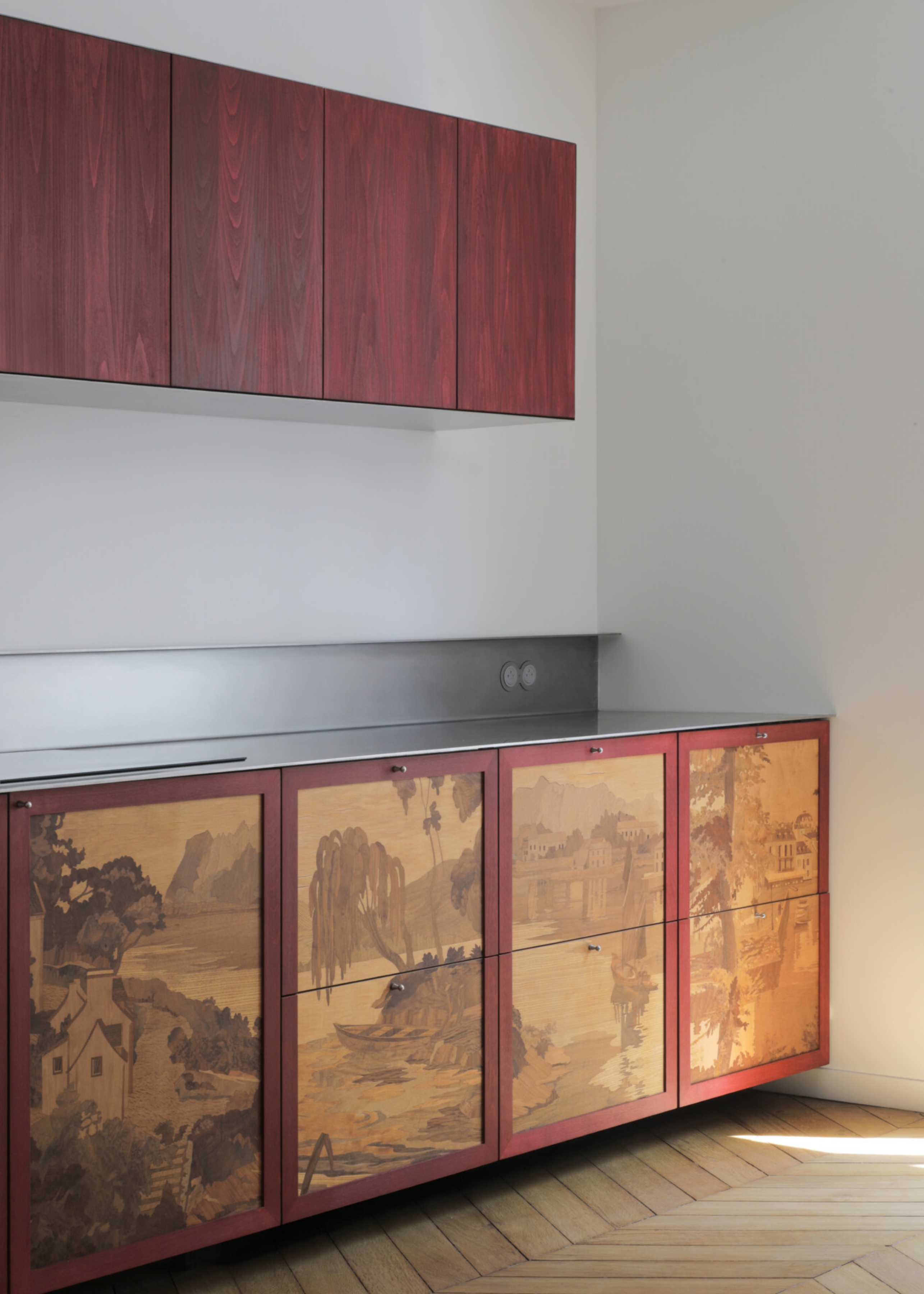
In this kitchen, the doors have been designed around 1930s marquetry panels, yet matched with more contemporary finishes.
Kitchens tend to come in ranges, even when you're buying from a luxury kitchen brand, so you're always picking pieces with the same design language as a unifying backdrop. For many kitchen makers, these ranges fall into two distinct styles: traditional and modern. The former typically features a Shaker-style door, often in-frame, while the latter showcases a more minimalist slab door.
However, recently, in kitchen design, I've noticed a marrying of traditional and modern, which reflects the wider 'modern heritage' trend, combining different elements of both old (-looking, at least) and new to create some tension through contrast. It's not a transitional kitchen in the classic sense — mixing the two extremes of the style rather than straddling them safely.
The kitchen of this Parisian apartment, designed by Amor Immeuble, is a prime example of how this idea can be played out. "The apparent complexity of the marquetry façades contrasts with the apparent simplicity of the stainless-steel worktop," the designer tells me.
The Livingetc newsletters are your inside source for what’s shaping interiors now - and what’s next. Discover trend forecasts, smart style ideas, and curated shopping inspiration that brings design to life. Subscribe today and stay ahead of the curve.
The marquetry mural, inset in the cabinetry fronts, feels like it belongs on the walls in some grand country estate, yet is paired with such a sleek stainless steel worktop and modern slab on the upper cabinets, that it strikes the balance between contemporary and historical in a way that gives this apartment a story to tell.
"Its design is simple, self-evident: it is a surface folded twice to serve as a countertop, backsplash, and shelf. However, its technical execution is complex and requires real craftsmanship. Conversely, the façades — and Art Nouveau in general, through its pursuit of representing nature — express in a very direct way all the complexity and diversity of craftsmanship."
2. The Decorating Trend: Ceilings
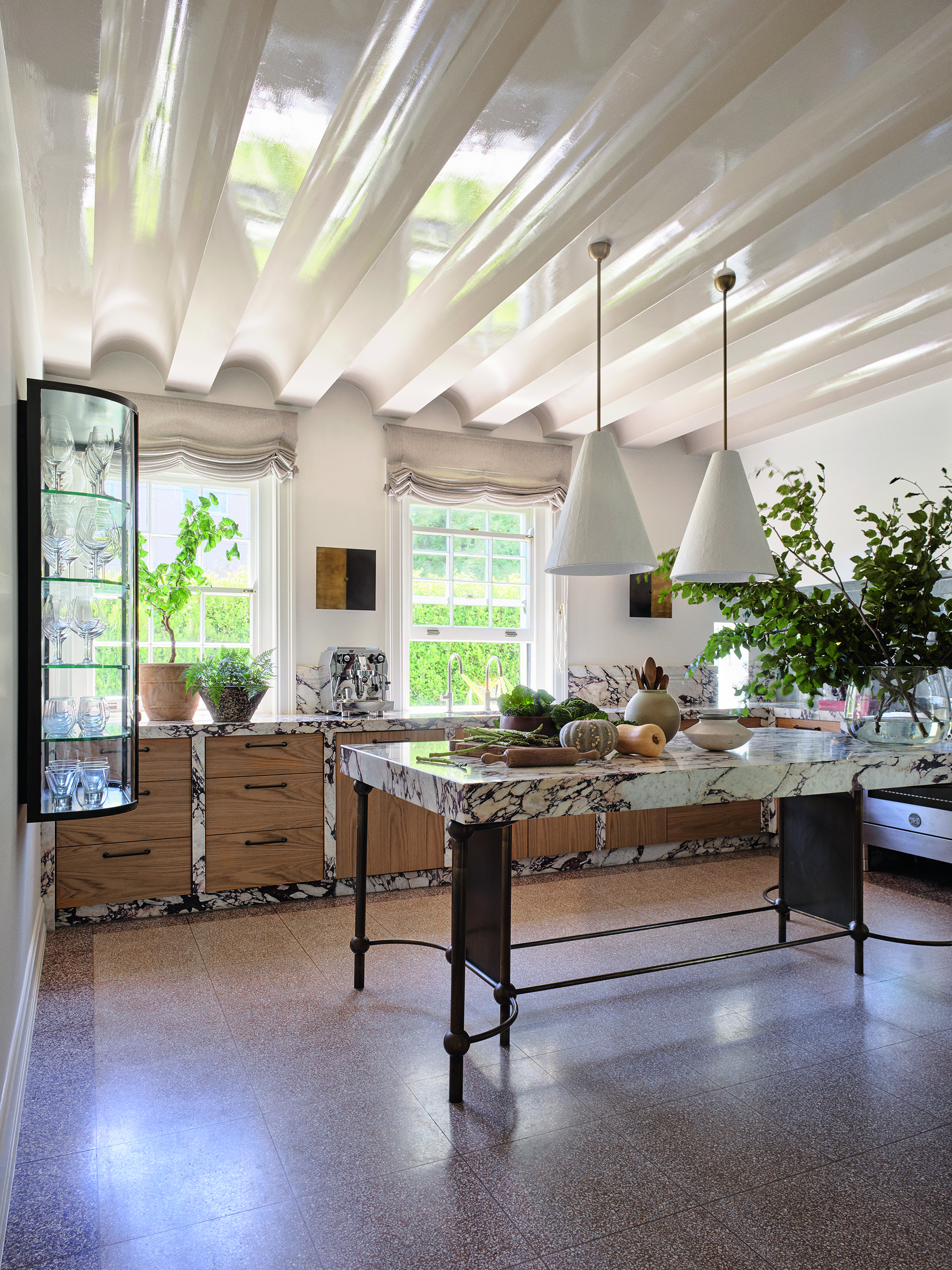
Lacquered surfaces are an emerging trend in furniture, but here it's used for this dramatic yet neutral ceiling design.
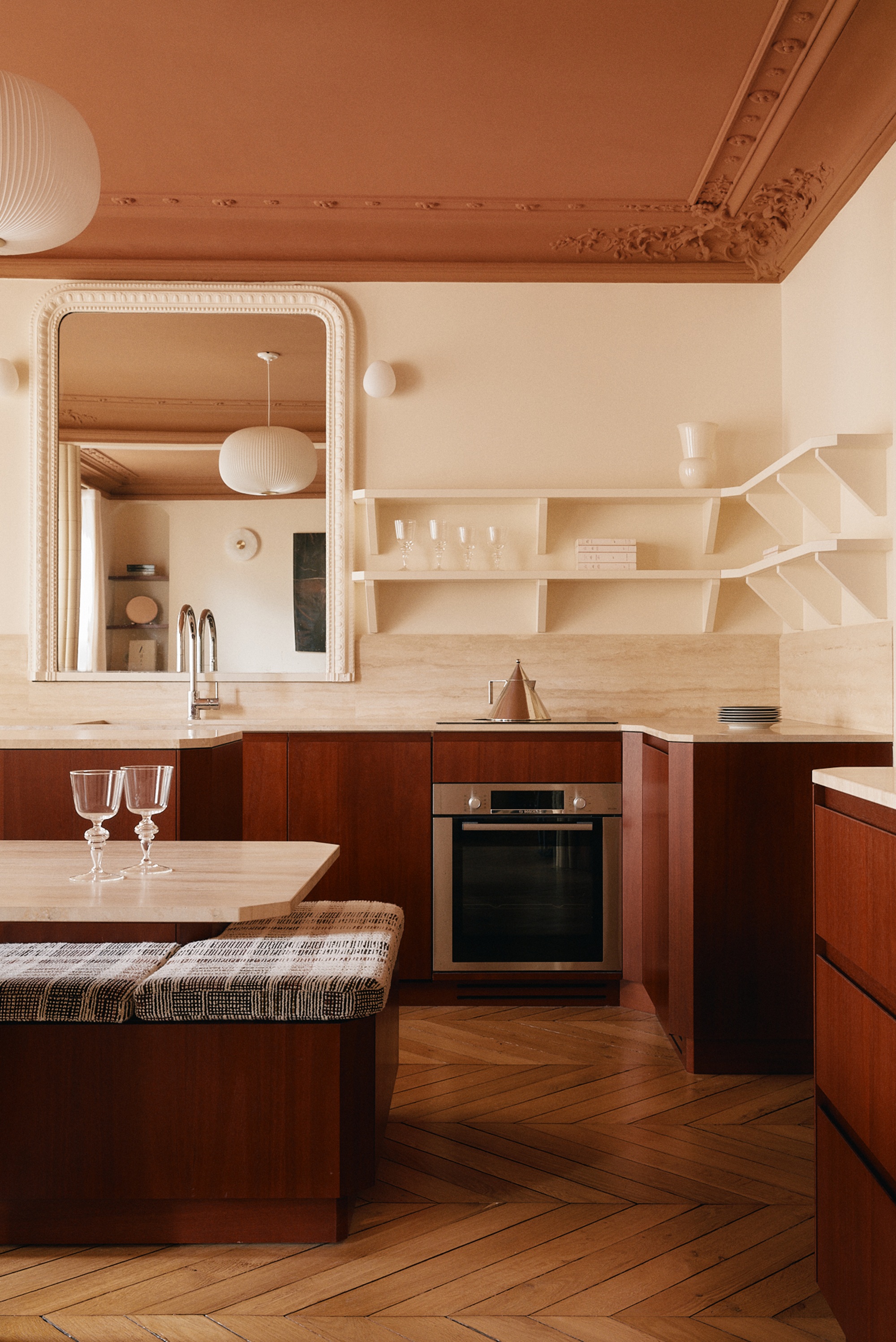
This marriage of old and new might also inspire the kitchen trend for decorating a ceiling creatively, too — after all, consider the frescoed ceilings of Renaissance times, drawing your attention skyward.
Take a kitchen like this, designed by Flack Studio, for example. It’s not the spectacular slab of Calacatta Viola marble forming the island that is the hero in this space. Nor is it the way the same stone snakes around the custom American oak cabinetry, though this is an impressive use of the rich veining.
Instead, it’s the mini vaults in the molded ceiling, and the way that they create an almost monastic or cathedral-like shape for this heavenly design scheme, echoing the curves of the island base and the wall-mounted glassware cabinet.
Elsewhere, we're seeing ideas like 'color capping' in kitchens, washing the room in tonal shades that culminate in a darker ceiling color.
3. The Color Trend: Spice
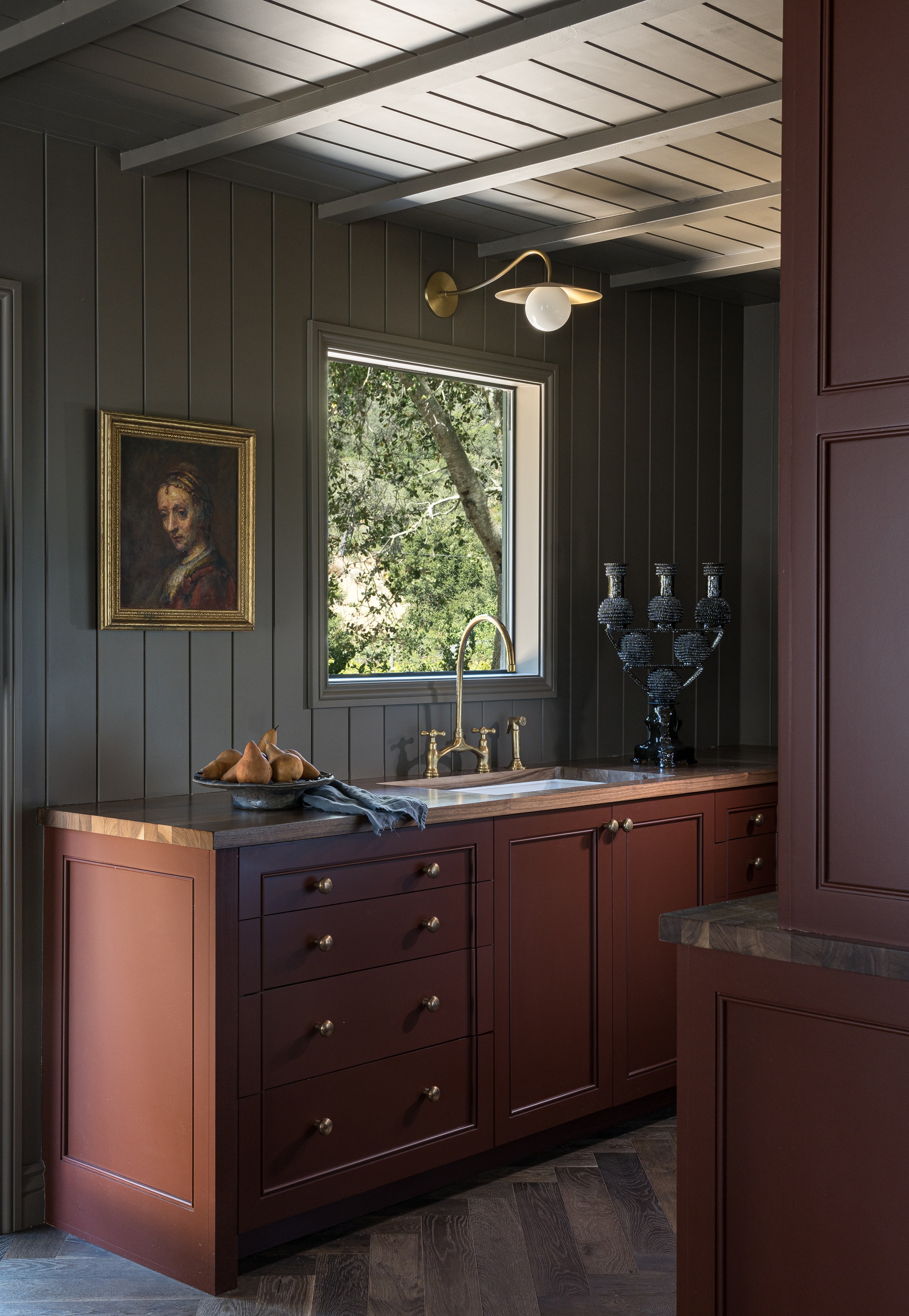
The cabinetry in this kitchen designed by design studio Hommeboys captures the warmth and elegance of spice-inspired colors such as sumac.
From golden turmeric to vibrant paprika, cabinetry in 'spice' colors feels perfectly aligned with the mood of the moment. This color trend can go any which way, feeling rich and sophisticated, an expensive-looking finish that shows confidence in your decorating style, or even something a little more fun and modern when used in bold color blocks and innovative materials.
For a near-neutral choice, I'm fascinated with this 'Sumac' color, coined by kitchen brand Tom Howley. Where last year's oxblood trend was a red-brown, sumac is more of a brown-red, a small but significant difference in how the color reads. It feels a lot more neutral, but has an undeniable warmth and energy underneath that not all brown tones do.
"Spice-inspired colors bring incredible warmth and depth to a kitchen," Tom tells me. "They immediately create a sense of comfort and richness that works beautifully in spaces designed for gathering and entertaining. These tones feel organic and tactile, while also adding a touch of vibrancy that makes a kitchen feel more personal and lived-in."
And, there's maybe the point. These colors don't feel, right now anyway, like they're an off-the-shelf option. They feel like something different, but without being novel for the sake of novelty.
4. The Material: Stainless Steel
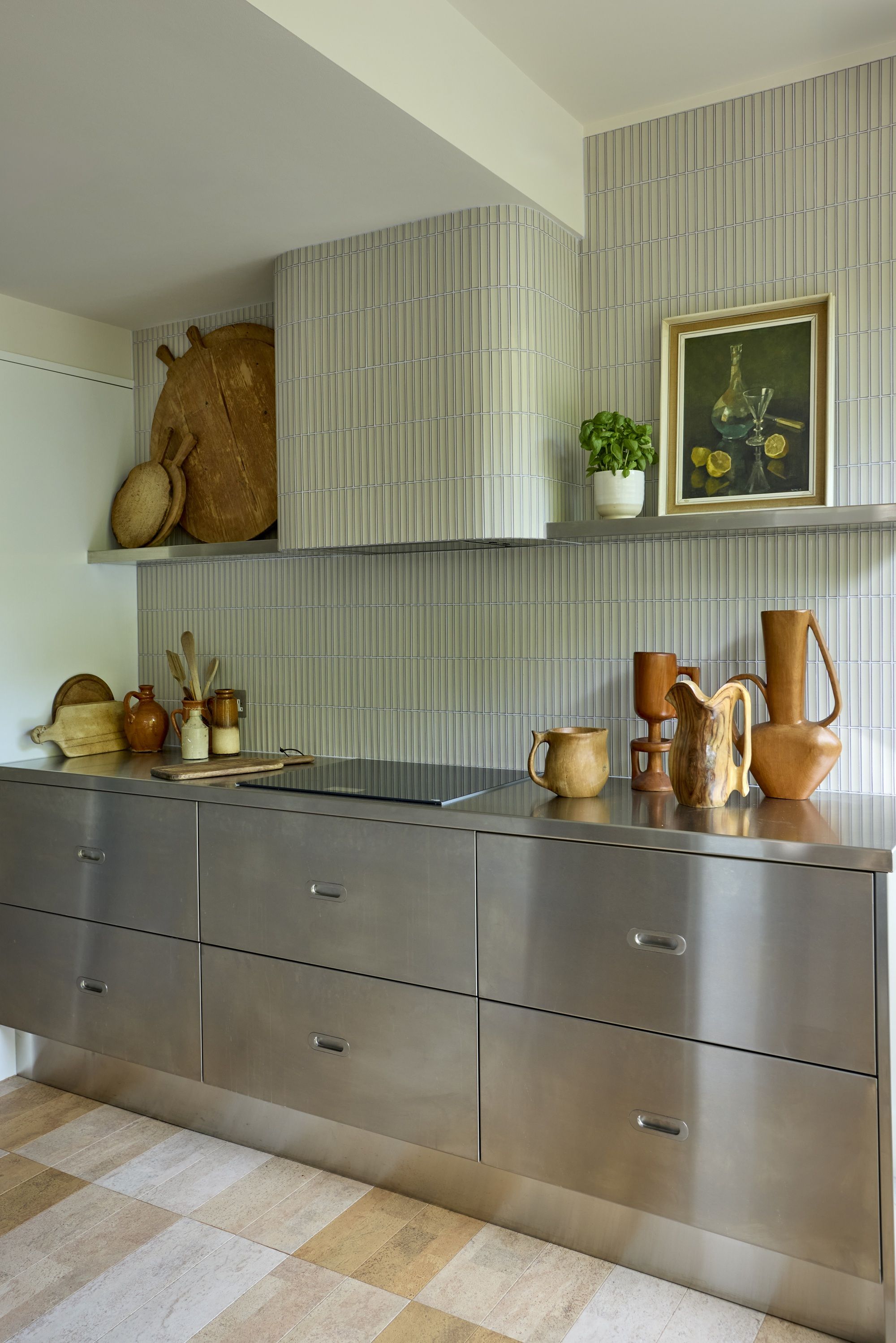
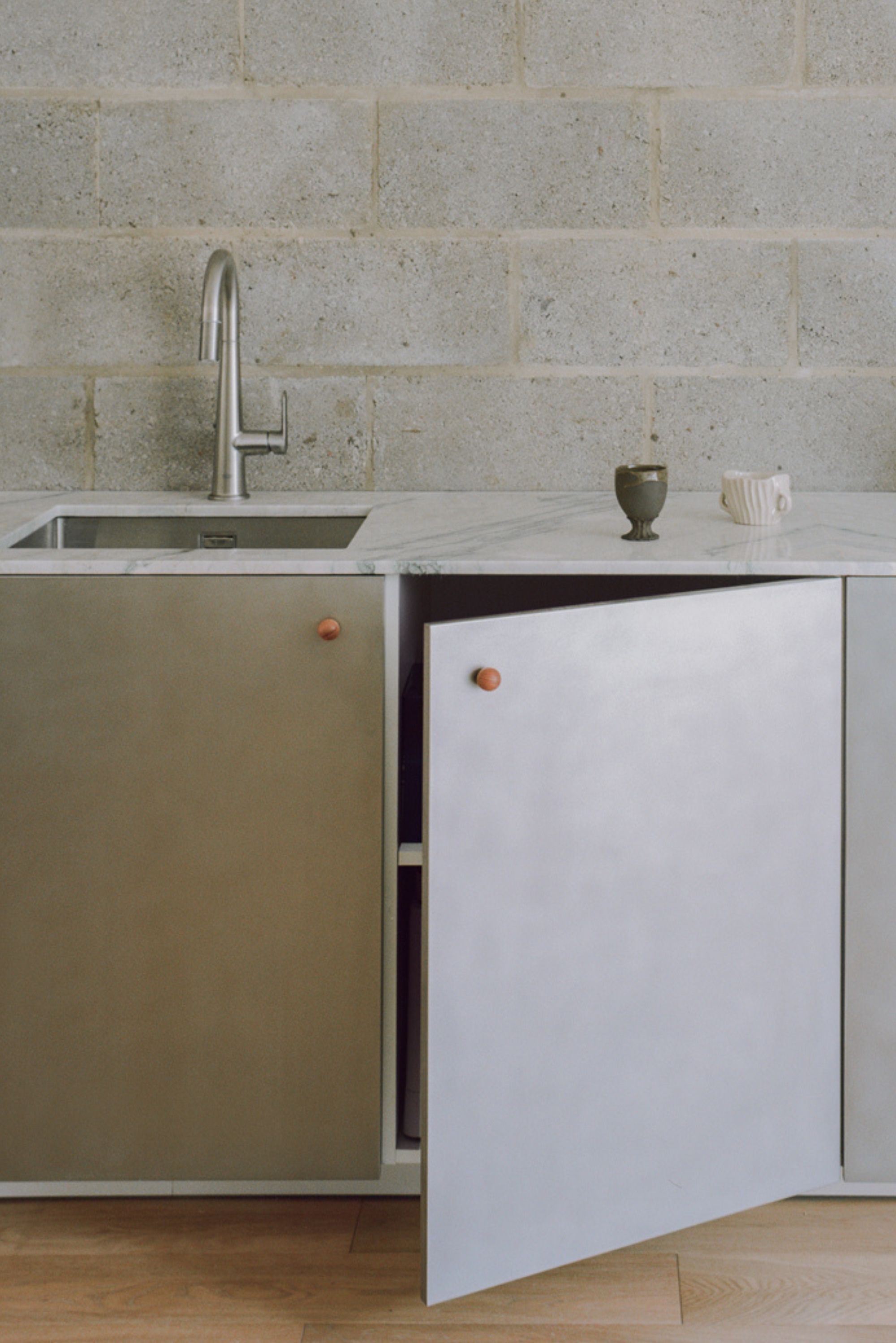
Stainless steel kitchens aren't anything new — even outside of professional kitchens, they've had a place in residential settings for some time now. However, what was once quite a cold, industrial take on kitchen design has evolved into something warmer, with creative contrasts that soften the look of this material and bring it more into the fold.
As well as classic stainless steel, we're seeing innovative takes on the metal that have more textural finishes — and that also provide an answer to some of its drawbacks, such as the fact that it scratches, marks, and has a tendency to showcase fingerprints.
The kitchen, above, by Flawk Studio, uses a proprietary brushed steel finish that captures the metal as a color trend, but completely changes its texture. "Stainless steel can feel very cold and industrial, thus playing with the finish unlocks the material beyond our preconceptions and stereotypes of it," says Ashley Law, director of Flawk Studio. "We've opted for a non-directional brushed finish which almost adds a weightless sensation to the material, softening and in a way, warming its appearance."
5. The Countertop Trend: Recycled and Sustainable
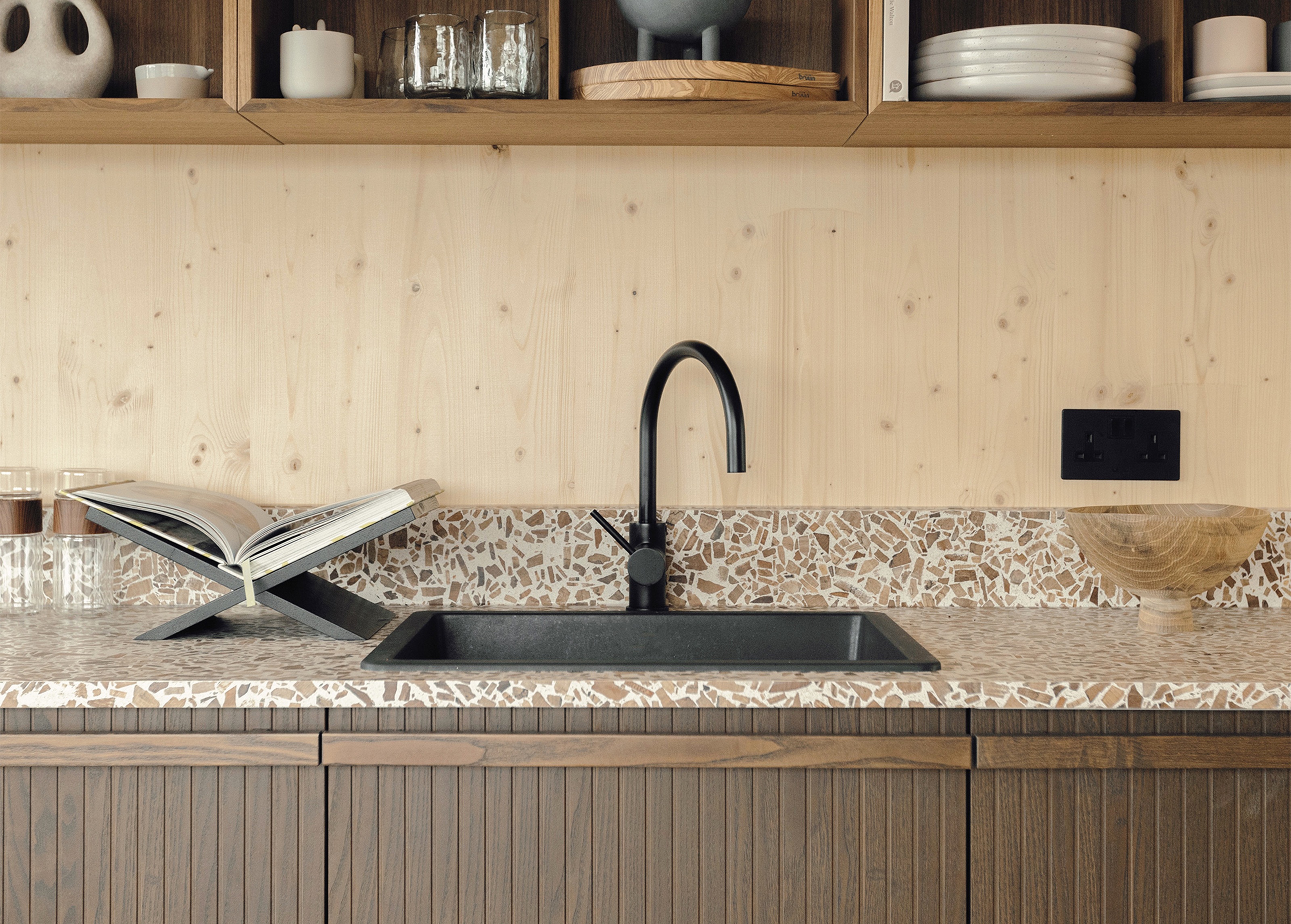
Foresso, a terrazzo made from timber offcuts, is one of Low Carbon Industrial's sustainable and eco-friendly countertop options.
I'm calling it, 2026 is the year where we'll see worktop brands aim to move away from quartz, an industry standard for years, to more innovative and sustainable ideas.
Surface brand Cosentino, makers of materials including Silestone and Dekton, has just announced Éclos, a new mineral material surface that's not only made from 50% recycled materials, but also contains zero crystalline silica — a quartz ingredient that has received negative press in recent years regarding the health and safety of its fabricators.
We're also seeing other interesting surface materials come to the fore. New materials company Low Carbon Industrial is a good example of a brand pushing forward new ideas. The company started as Foresso back in 2016, creating countertops made from 'timber terrazzo' made using British wood offcuts, but has gone on to introduce new products, including Elinite, which is made from natural waste from walnuts and bamboo, using its circular manufacturing philosophy.
"We live in uncertain, fragile times, and the rise of consumer interest in sustainability can be seen as a response to our ongoing need to consume," co-founder Conor Taylor tells me. "It’s people finding a balance between consumerism and personal ethics that has led to a more thoughtful approach to how we shop, where we shop, and what we buy."
6. The Layout: Partition Kitchens
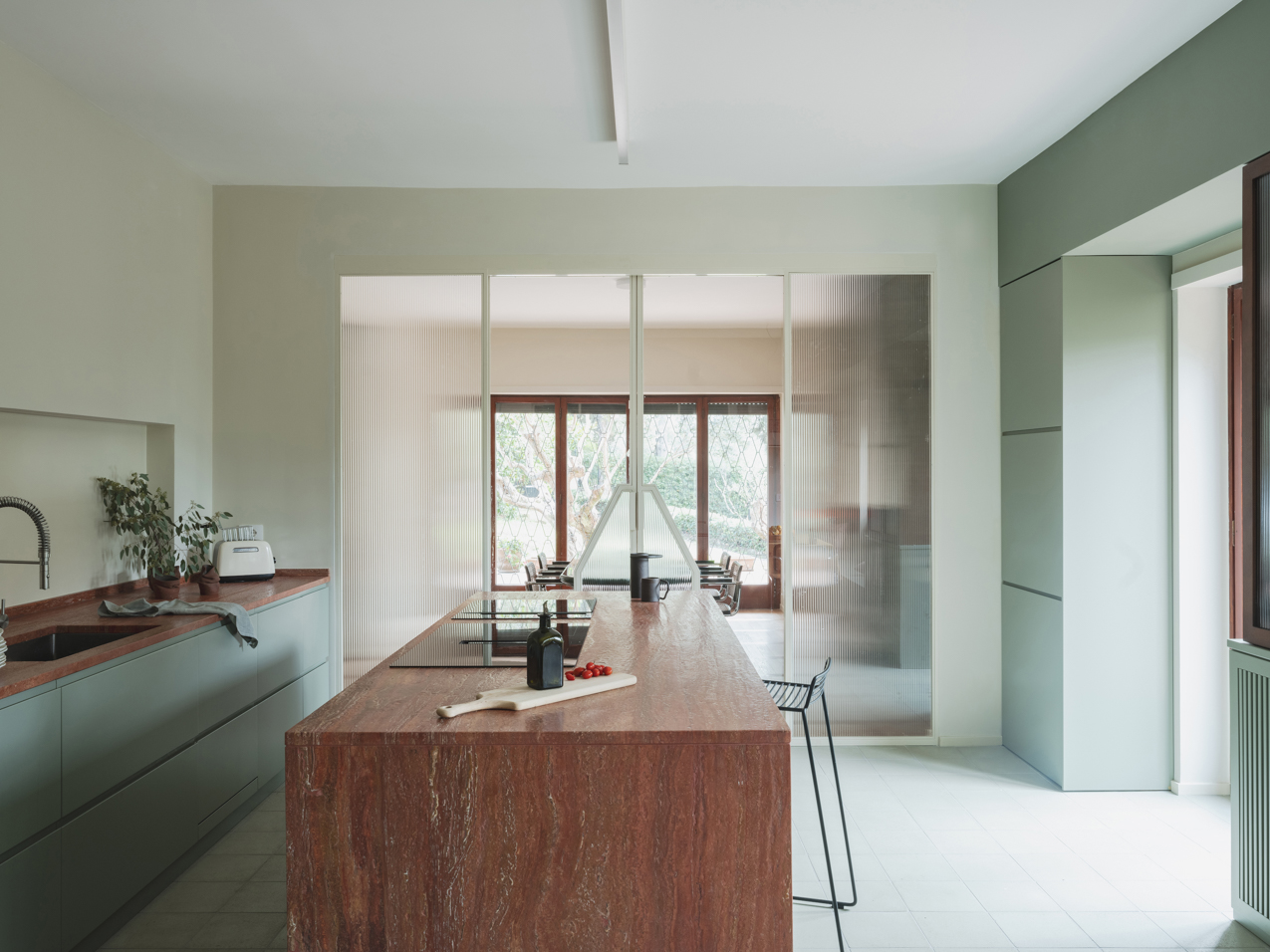
Sliding doors between the kitchen and dining room help separate functions when doing something like hosting guests.
We've lived with the open plan kitchen experiment for long enough now to be fully aware of both this layout's benefits and its drawbacks. What we gain in openness, bright, light spaces, and a better sense of connection, we can often lose out on the ability to create privacy and quiet, as well as sacrificing that cozy, enveloped feeling you get from rooms on a smaller scale.
The best of both worlds solution is the partitioned kitchen, offering you a divide when you want it, using vast glass doors to not lose the sense of the open plan dream.
You might think it's an apologetic halfway measure; however, far from being a discreet design intervention, these partitions are also an opportunity for designers to add extra design flair to the space.
Take, for example, this kitchen in a villa to the south-east of Rome in Italy, designed by STUDIOTAMAT to 'deliver stimulating and relaxing spaces in equal measure,' co-founder Matteo Soddu says.
The kitchen partition does both these things — creating privacy and a physical divide between the dining space and kitchen, but with the intrigue of the 'central rhomboid motif — a nod to the original 1950s ironwork found throughout the villa,' Matteo explains.
7. The Hardware Trend: Dowel Handles

Made of the same material as the door, the dowel handle is an easy pairing which doesn't require adding more finishes into your scheme.
Rather than a particular type of door pull or knob being the trend of the moment in kitchen design, I'm seeing integrated styles worked into these spaces a lot more. That's not to say they're handleless — this style of kitchen still often has protruding handles, but they feel as though they're a part of the door, rather than something distinctly separate in material and form.
The name is a little hard to come by if you're looking for a handle like in the kitchen, pictured, but at KL Design, designer Angelica Smith often refers to them as 'dowel' handles. "They’re essentially a playful, contemporary twist on the classic edge pull," Angelica tells me. "By softening that linear, angular look, they add a load of personality and signal that the kitchen is truly bespoke, while keeping the overall aesthetic simple and pared-back."
The good news is that this kitchen hardware trend might not actually be a budget-busting addition to your renovation, especially compared to some luxury kitchen handles. "They’re easy to produce, so they’re often a more affordable option too," Angelica says. "The only practical consideration is that they might not be ideal for anyone who needs a larger, more ergonomic grip," the designer says.
8. The Island Trend: Irregular Shapes

The traditional rectangular island isn't a bad kitchen layout by any means, but what this structured format perhaps doesn't allow for is the somewhat unpredictable ways in which people actually use a kitchen.
That's where we're seeing more irregular shapes used for kitchen island ideas, introducing undulating curves in less rigidly prescribed forms and a breakaway from more standardized linear or pill-shaped styles, that feel like they fit the home more organically. It feels like an antidote to the one-size-fits-all approach.
Take this unusual trapezium-shaped island in the New York kitchen of interior designers Britt and Damian Zunino. Clad in patinated burnished brass with a Calacatta Monet honed countertop, it's set on the skewiff. It juts into the space, drawing you in rather than blocking you off in the way a purely flat front might not. "Angling the island softened the rigidity of the otherwise orthogonal layout, encouraging circulation and creating a natural, sculptural flow through the space," says Britt.
9. The Wood Trend: Espresso Tones

This wall of bespoke cabinetry is made from aged oak, and even hides a walk-in larder.
Once upon a time, 'light and airy' were the only characteristics people seemed to care about, and it came at the expense of certain design choices, including darker timber. Now, we're seeing more variety in finishes across the light-to-dark spectrum, with people less afraid to lean into the positive traits of dark wood. They're richer-feeling, often have more character, and are actually surprisingly versatile across a range of kitchen styles.
Lizzie Spinks, head of design at Makers, sees the kitchen trend stemming from a resurgence in mid-century styles, however. "These richer, deeper wood tones bring warmth to the space, but also a touch of vintage sophistication," the designer says. "They also give clients the confidence to experiment with bolder patterns and textures, creating kitchens that feel more individual."
However, it's fair to say that not all dark woods are being embraced in the same way. It's the rich, warm espresso tones that are making the biggest impact in design, while the retro cherry wood style colors still have some ground to gain.
10. The Tile Trend: Modern Delft
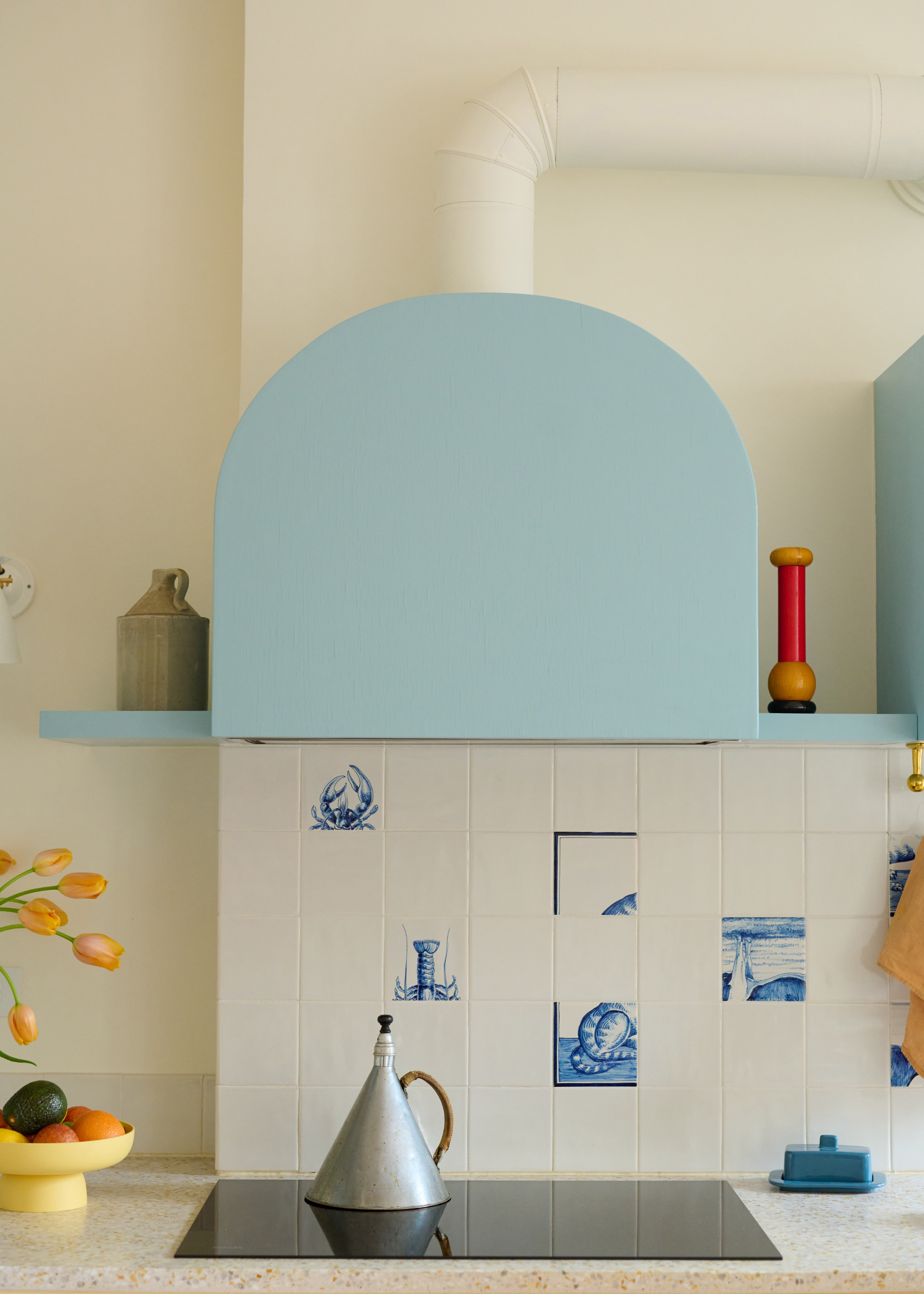
Delft tiles are about as traditional-leaning as tiles come, so why do they feel like a breath of fresh air for a modern kitchen backsplash? These heritage tiles date back to some 17th-century, imitating even older blue-and-white Chinese ceramics, so for anyone looking to imbue their kitchen with a bit of history and some grounding authenticity, these tiles find a natural home.
That's not to say this kitchen trend sees them being used in the same ways as traditional Delft tiles have been. In a kitchen, like the above, by architect Ethan Pomerance, a deconstructed collage gives a "modern or surreal twist on what is usually a very charming and evocative but still traditional tile," Ethan tells us. We're also seeing bespoke, personalized Delft tiles, showing ever more extraordinary and yet everyday motifs. In designer tile ranges like Petra Palumbo's, you'll find the likes of washing machines, blocks of cheese, and sudoku grids as motifs for this modern take on Delft.
What this tile trend offers is a level of hyper-customization to your kitchen that makes it feel like it's designed for you only. Just don't ask how it'll affect the resale value.
These kitchen trends aren't just a signifier of what your kitchen looks like, they're about making a kitchen work better for you. And, while the aesthetic of some of these trends will undoubtedly shift over time, this desire is pretty timeless in nature.

Hugh is Livingetc.com’s editor. With 8 years in the interiors industry under his belt, he has the nose for what people want to know about re-decorating their homes. He prides himself as an expert trend forecaster, visiting design fairs, showrooms and keeping an eye out for emerging designers to hone his eye. He joined Livingetc back in 2022 as a content editor, as a long-time reader of the print magazine, before becoming its online editor. Hugh has previously spent time as an editor for a kitchen and bathroom magazine, and has written for “hands-on” home brands such as Homebuilding & Renovating and Grand Designs magazine, so his knowledge of what it takes to create a home goes beyond the surface, too. Though not a trained interior designer, Hugh has cut his design teeth by managing several major interior design projects to date, each for private clients. He's also a keen DIYer — he's done everything from laying his own patio and building an integrated cooker hood from scratch, to undertaking plenty of creative IKEA hacks to help achieve the luxurious look he loves in design, when his budget doesn't always stretch that far.